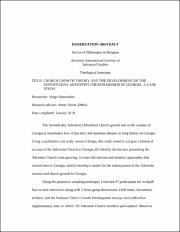| dc.description.abstract | The Seventh-day Adventist (Adventist) Church growth rate in the country of Georgia is remarkably low. It has only 368 members despite its long history in Georgia. Using a qualitative case study research design, this study aimed to (a) give a historical account of the Adventist Church in Georgia, (b) identify the barriers preventing the Adventist Church from growing, (c) trace the mission and ministry approaches that worked best in Georgia, and (d) develop a model for the enhancement of the Adventist mission and church growth in Georgia.
Using the purposive sampling technique, I selected 47 participants for in-depth face-to-face interviews along with 5 focus group discussions. Field notes, documents, artifacts, and the National Church Growth Development surveys were utilized as supplementary data, in which 150 Adventist Church members participated. Historical
documentary analysis revealed that persecution and loneliness were constantly pressuring Adventists in Georgia. This study discovered unknown but important individuals who significantly contributed to the Adventist mission in Georgia. Through thematic data analysis, a total of 20 themes and 54 categories emerged in an attempt to answer the 3 research questions. The external and internal barriers such as (a) social pressure, (b) Georgianness, (c) modernization and progress, (d) occupational pressure, (e) organizational disconnection, (f) frustration, (g) use of effective methods of evangelism, (h) lack of discipleship, and (i) uninvolvement of the laity all present significant hindrances to the Adventist mission and church growth in Georgia.
Despite these barriers, this study has revealed that Adventists in Georgia are able to win souls when they are successfully led through the necessary stages. These stages are depicted in 6 emerging themes: (a) focusing on responsive groups, (b) employing attractive features, (c) expanding the network, (d) earning the right to share the Gospel, (e) using effective evangelistic methods, and (f) recognizing the work done by the Holy Spirit. As such, instead of a single-step strategy, a multiple-step mission strategy is proposed. Furthermore, the Natural Church Growth Development survey analysis and the participants’ reports helped identify the areas for improvement. These are (a) enhancing church health, (b) developing the appropriate mission strategy, (c) acknowledging the role of a foreign missionary, (d) adapting meaningful communication and cultural appropriateness, and (e) addressing Georgian aesthetics and the culture of prestige. | en_US |

